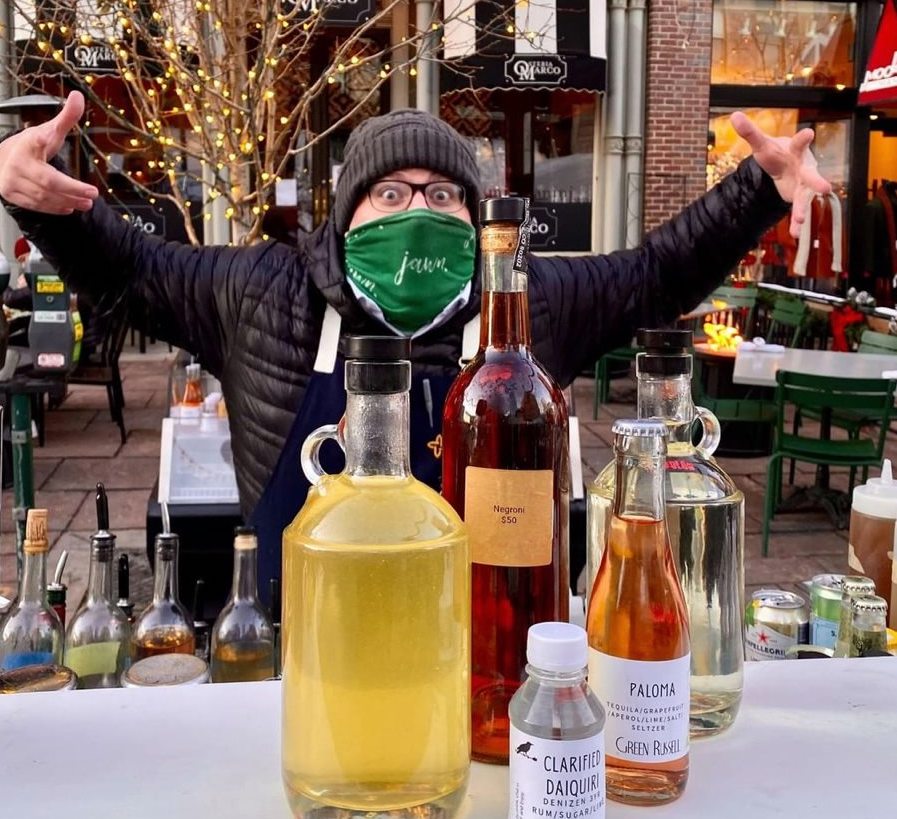On Thursday, May 12, federal health officials from the U.S. Centers for Disease Control and Prevention said what we’ve all yearned to hear: Fully vaccinated people no longer need to wear a mask or socially distance during outdoor or indoor gatherings. After more than a year of doing both, that declaration is the most robust easing of Covid-19 restrictions since the global pandemic shattered our world. Light at the end of the tunnel. Finally. And with the lifting of those constraints, we’re entering a modicum of normalcy, although it’s anyone’s guess what that’s going to look like.
This past year was riddled with shock and strife, mourning and anxiety, anger and exhaustion. And restaurants, especially, suffered heart-wrenching setbacks. But for diners, there were snips of sunshine poking through the pandemic’s dark clouds, some of which should remain in place in restaurants as we move forward.
Properly spaced tables, for example. Restaurants, understandably, need to make money, and that means seating as many patrons as possible. Still, there’s nothing worse than having the back of your chair a hair apart from the person perched directly behind you. We all appreciate space. Do we need six feet of separation? No, but none of us is interested in overhearing the cell phone conversation of our loud-mouthed neighbor, and nor do we want to trip on the purse strap of the woman who leaves her bag, which doubles as luggage, in the middle of the aisle. And while home is where the heart is, we’ve been cooped up long enough, and when we go out to eat, we want a degree of privacy. Sure, fewer tables may lead to increased menu prices, but Denver restaurants are inexpensive compared to other major metropolitan cities.
In a city that ballyhoos 300 days of sunshine per year, the pitch for all-season outdoor dining is a no-brainer. And with the proliferation of greenhouses, tents, windowed igloos, yurt villages, enclosed dining pods, cabanas, gondolas and even wooden barrels, there’s no reason why we Coloradans can’t continue to layer once the pandemic is in the past. I mean, this is a state where half of its inhabitants wear T-shirts and shorts in a blizzard. We can handle the elements. Restaurants: Please, please make outdoor dining a permanent thing.
Also in the keep-it-don’t-kick-it category: to-go alcohol sales. Bartenders worked their tails off during the pandemic, churning out spirited cocktails — often in beautiful glass bottles — so we wouldn’t have to sacrifice our safety at liquor stores or supermarkets. Neighborhood bars like Asbury Provisions sold (and delivered) mason jar cocktails (delicious!), brilliant craft beers and heavily discounted wines, many of which were far more affordable than liquor store prices. And in one of the best decisions ever made, the Colorado House of Representatives recently passed HB-21-2027, which allows restaurants and bars to continue offering alcohol beverage takeout and delivery well into the future. Considering that more than 90 percent of restaurant operators who responded to a recent Colorado Restaurant Association Impact Survey received revenue from to-go alcohol sales, it’s clear this is a pivot that should persevere.
Honoring and respecting our essential workers — the people who feed us, serve us and go to great lengths to ensure our safety — should not be forgotten once the pandemic pulls out of the station. Restaurant staffers busted their asses to fill our bellies, stock our shelves with staples (toilet paper!) and so much more and unselfishly put themselves at risk every single time they delivered food to your home or office. And in case you haven’t heard, there’s a severe staffing shortage in the hospitality industry, which means one employee is doing the work of an army. Most of us realized this during the height of the pandemic and went out of our way to express our gratitude with howls, yard signs, sidewalk chalk art and larger tips. Let’s continue to treat hospitality workers with the respect they deserve.
Takeout took off during the pandemic, and for once we weren’t regulated to fried rice and soggy pizza. The city’s best chefs and restaurateurs jumped on the takeout bandwagon and quickly stepped up their game to package orders to mimic — as best they could — a restaurant dining experience. Gussied up cutlery and plateware, handwritten thank you cards, fresh flowers, offers for future discounts and “These are on us” desserts often accompanied takeout orders. We hope restaurants continue to fulfill takeout orders with the same passion that fuels them inside their restaurant dining rooms.
Remember early on in the pandemic when hand sanitizer and Clorox wipes were zapped from the shelves before the sun rose? How many of us spent countless hours refreshing our browser on Amazon, desperate for replenished stock? Or stood in line at the grocery store in frigid weather just so we could get our limit-of-one container of wipes? Glad those days are over, but increased sanitation practices at restaurants certainly resulted in cleaner dining rooms, kitchens and bathrooms. Hand sanitizer on tables, in the loo and at the host stand should stick around. It’s cheap, and it goes a long way in stopping the spread of viruses. Make it a staple. Just like bread.
Pedestrian-only streets, which prior to the pandemic were open thoroughfares for speeding cars and parking nightmares, became a (great) thing in 2020. Larimer Square morphed into a lovely alfresco oasis for dining and drinking, with pop-up cocktail stations and illuminated patios, greenhouses and tents taking precedence over automobiles. The RiNo District followed suit, as did Glenarm Place. And the trend even extended to the mountains; Idaho Springs closed much of Miner Street — its main drag — to allow locals and tourists alike to eat and imbibe absent the proliferation of vehicles. We’d love for this pivot to persist.
— Lori Midson




Leave a Reply